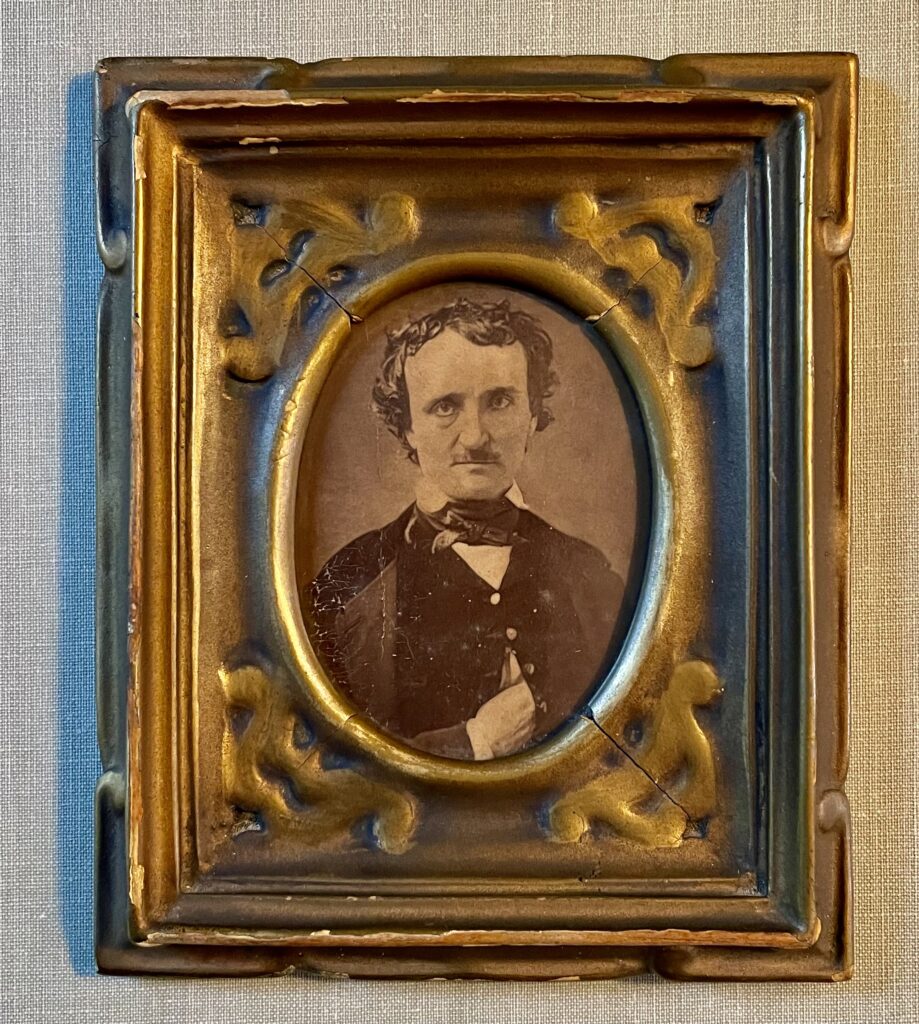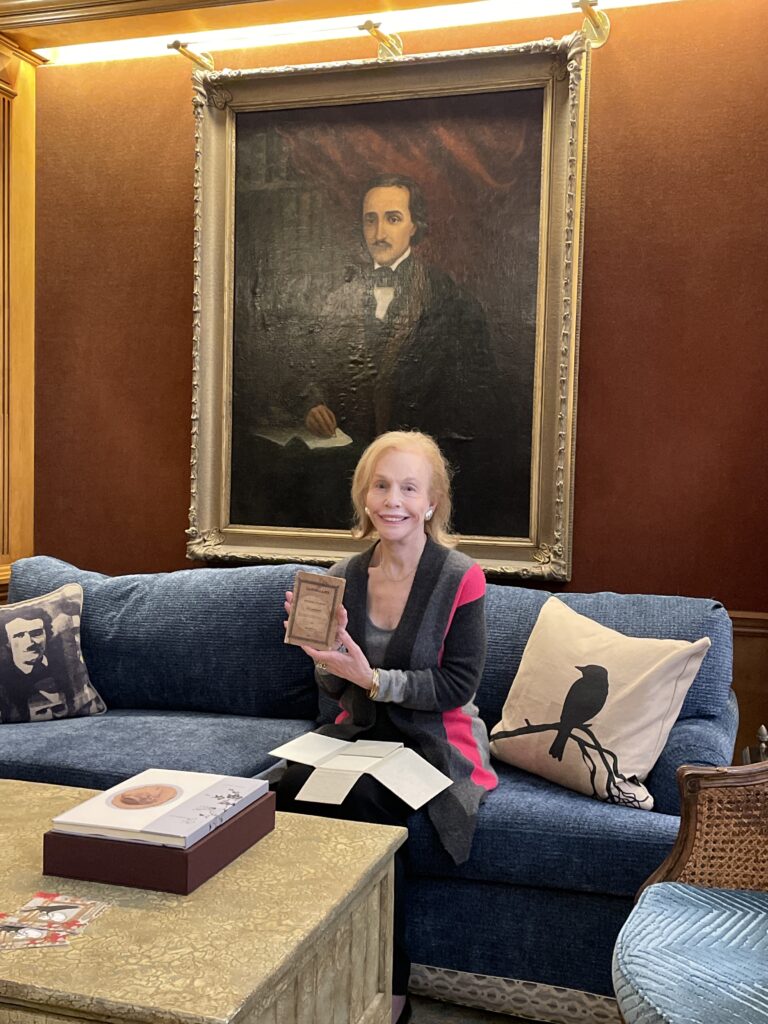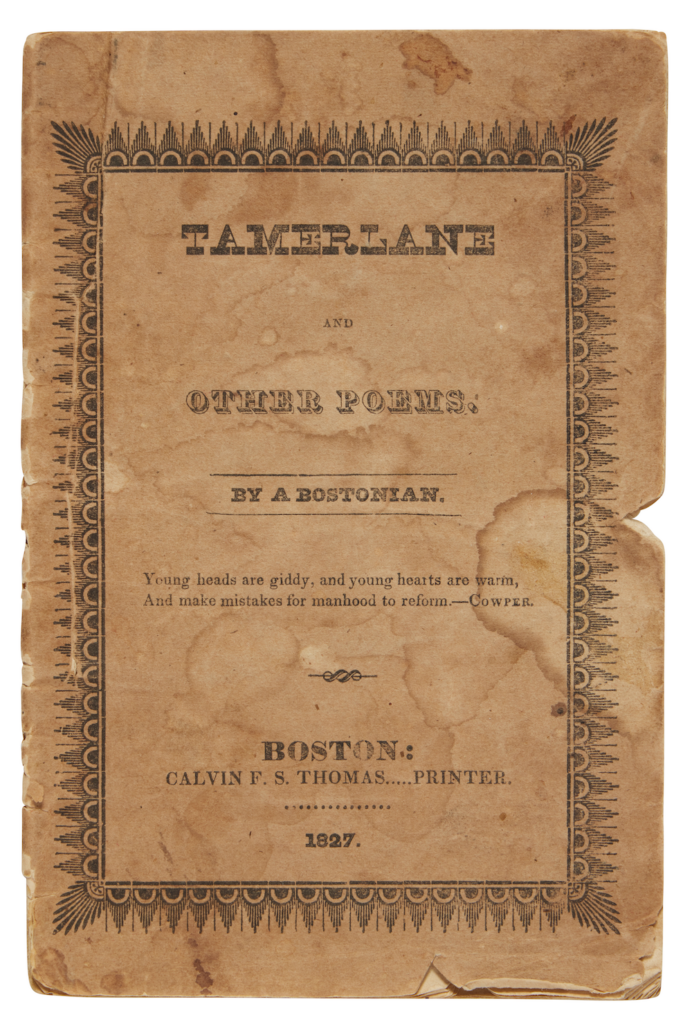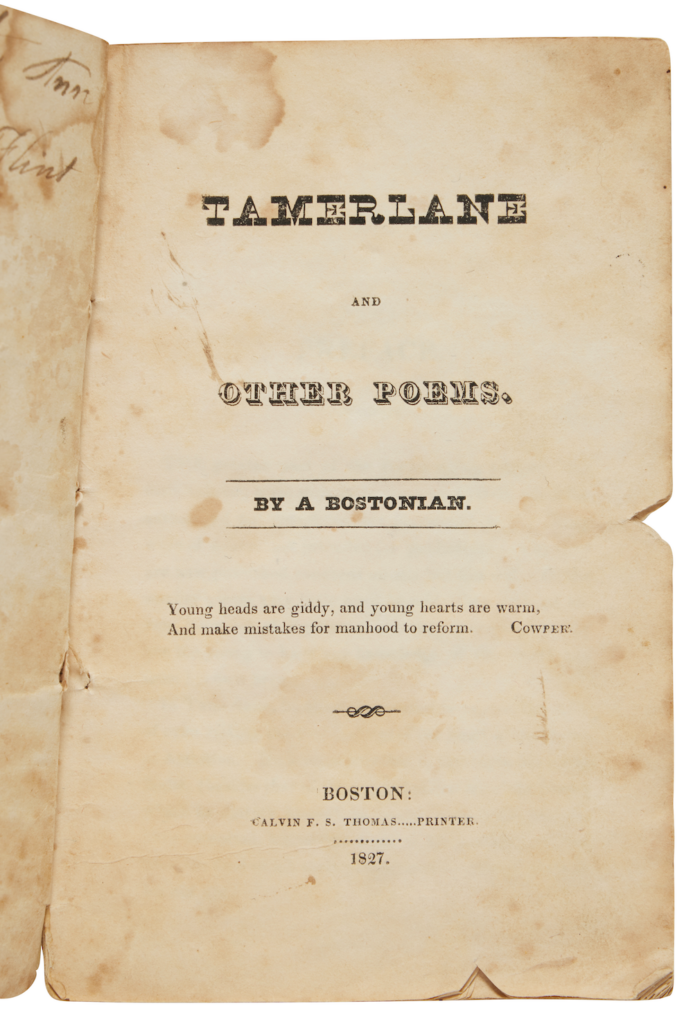
In Search of the Rarest Book in American Literature: Edgar Allan Poe’s Tamerlane
Bradford Morrow on the Bibliophile’s Holy Grail, Otherwise Known as the “Black Tulip”
My first personal encounter with the rarest book in American literature was memorable, even moving, for many reasons, but its physical appearance wasn’t one of them. If ever a book ought not to be judged by its cover, Edgar Allan Poe’s debut collection, Tamerlane and Other Poems, is that book. Known as the Black Tulip, only twelve copies appear to have survived since its publication in July 1827. That one of the last two in private hands is coming to auction this month, not quite two centuries later, marks an historic bibliophilic event.
Both Poe and the novice printer Calvin F.W. Thomas were just eighteen when the poet handed over his manuscript, presumably at Thomas’s shop at 70 Washington Street in Boston, and paid him to make it into a book. The result was forty pages of unevenly printed verse bound in drab tan wrappers the shade of a faded tea stain. Tamerlane’s front cover features a potpourri of discordant typefaces within an ornamental frame that resembles a geometric queue of conifers—a heavy-handed period design I have grown to adore. It’s clear that Thomas, as a workaday job printer whose usual commissions were show bills, apothecary labels, calling cards, and the like, had his shop stocked with a mishmash of typefaces to fit any taste. On this occasion, he seems to have drawn liberally from his inventory.
While there’s no evidence to suggest the printer realized its significance before his death in 1876, his modest hand-sewn pamphlet marked the beginning of one of the most revolutionary, incandescent, and influential careers of any writer in his, or any, century. It is speculated that Calvin Thomas’s family were acquainted with Poe’s birth parents, Eliza and David, in Boston, and that the teenaged Poe knew of him that way. But Calvin’s business was included in the Boston Directory, so it’s every bit as likely he hired him through this listing.
The young poet, who’d left Richmond, Virginia, after dropping out of university when his foster father, John Allan, gave him insufficient funds to continue (Edgar had racked up gambling debts in a reckless attempt to make up the difference), may not have shared his identity with Thomas when the printer produced his “little volume” with its “many faults.” Indeed, Poe’s name is nowhere to be found in Tamerlane. Its authorial attribution is simply “By a Bostonian.” Its Preface, at once boastful and self-defensive and very Poean, is unsigned.
 Albumen print of “Stella” portrait of Poe (1876) from 1849 daguerreotype original. Courtesy of the author.
Albumen print of “Stella” portrait of Poe (1876) from 1849 daguerreotype original. Courtesy of the author.
Inconspicuous, fragile, published sans fanfare, ignored by reviewers, its sales poor, had Tamerlane been Edgar Allan Poe’s only publication, a one-off chapbook of melancholy romantic verse, it would now be a mere bibliographical curiosity. A fugitive document of interest to some scholar of early Lord Byron imitators or a specialist—are there any?—of Boston job printers of the period.
Instead—because its author went on to invent the modern detective story (think “The Murders in the Rue Morgue” and “The Purloined Letter”), revolutionize the Gothic genre with tales like “The Cask of Amontillado” and “The Tell-Tale Heart,” pen triumphs of supernatural horror like “The Fall of the House of Usher,” and write the classic macabre poem “The Raven,” which many of us tried to memorize as kids—Tamerlane, for its now-insignificant deficiencies as a poem and a pamphlet, is of towering importance to Poe specialists and aficionados alike.
The Holy Grail of book collecting, Tamerlane is one of those books that—like Mary Shelley’s Frankenstein in the original boards, which sold at Christie’s in 2021 for $1.17 million, or Shakespeare’s first folio, priced at $7.5 million and sold last year by the London-based rare book firm Peter Harrington on its 400th anniversary—causes a stir among rare book enthusiasts whether or not they have any hope, or desire, of acquiring it. (Not to mention the Bay Psalm Book or even the Eliot Algonquin Bible, other ultra-rare early American printed books, though religious texts, not literary.) Whenever a first edition of Tamerlane comes under the hammer—a rare event in itself—its past legacy and future home become the topic of discussion among booksellers, archivists, collectors, and Poe scholars around the world.
Originally produced in an edition estimated at forty or fifty copies, Tamerlane was from its inception a rarity. The Morgan Library doesn’t own a copy. Nor does the Library of Congress. The copy once held by the University of Virginia, Poe’s not-quite alma mater, was stolen in 1973 from the McGregor Room vault in Alderman Library. If it is never recovered, an unfortunate possibility, the number of known copies drops to eleven. At least one prominent Poe expert I know speculates it may have been destroyed to hide the evidence. After all, it would be wildly risky to try to sell the copy. Where in the world would a fence safely offer it? Besides, the theft, a presumed inside job, happened long enough ago that it’s not inconceivable the thief is dead. Wherever it is out there in illicit limbo, one hopes that whoever has it will earn their gothic angel’s wings by restoring it to the Alderman. Poe himself, while not given to happy endings, might have conceived an imaginative way for it to return, like Lady Rowena in his early tale “Ligeia,” from the dead.
My own first experience with Tamerlane came when I was invited by Susan Jaffe Tane, the most renowned of contemporary Poe collectors—no close second—to examine her copy along with some of her other treasures. These include important copies of all his books along with many original manuscripts, autograph letters, oil and daguerreotype portraits, a lock of his hair, even the tiny gold engagement ring Poe had given to Sarah Elmira Royster in 1849. At the time, back in 2018, I was researching my novel The Forger’s Daughter, which centers on a complex scheme to counterfeit a thirteenth Tamerlane. Despite the unsavory conspiracy in my narrative, in which an authentic copy is stolen and replaced with a sophisticated fake—recent thefts of Pushkin first editions from libraries across Europe that were replaced by persuasive forgeries are a vivid case of life imitating art—Tane was interested in helping me.
 Susan Tane with her Tamerlane. Courtesy of the author.
Susan Tane with her Tamerlane. Courtesy of the author.
Diminutive in stature, prodigious in energy, with alert blue-green eyes and the faintest hint of the Long Island accent of her youth, Susan Tane is a prototypical force of nature. After meeting me at the door of her Upper East Side apartment, she poured me coffee and promptly sat me down to ask how she could help with my project. (Her dining room, by the way, doubles as a library for an extensive Mark Twain collection; she collects Whitman and Melville in depth as well.) Even before showing me what I came to see, she began giving me copies of Tamerlane–relevant printouts and articles, and methodically dialed me in to her vast network of Poe scholars who could help with this or that recherché query. Sitting at the computer in her kitchen, she emailed letters of introduction to Jeffrey A. Savoye of the Edgar Allan Poe Society of Baltimore, to Chris Semtner at the Poe Museum in Richmond, and, among others, to Richard Kopley, a preeminent Poe authority whose biography, Edgar Allan Poe: A Life, comes out with the University of Virginia Press in February. That accomplished, she led me into her Poe room to meet the Black Tulip.
Just five Tamerlanes are complete with their original wrappers and Tane’s is one of them. It’s safe to say that hers is easily the most recognizable, with a prominent ring stain on its front wrapper, the result of somebody having used it as a coaster for their wet glass (of whiskey, I like to imagine). This inadvertent bit of vandalism is now hard to imagine. But Tamerlane wasn’t widely known beyond Poe specialists until the writer Vincent Starrett published an article in a 1925 issue of the Saturday Evening Post. “Have You a Tamerlane in Your Attic?” instantly raised the public’s awareness of the book’s significance, rarity, and value. Starrett’s column is credited with precipitating the discovery of some five previously unknown copies.
Could our thirsty vandal have made their mark, so to say, before “Attic” came out? Or maybe never read it? Either way, Tane’s copy was discovered in 1988 in a bin of old farming pamphlets at an antique shop in Hampton, New Hampshire, when a vigilant collector bought it for $15 and resold the book, which then made its circuitous way through Sotheby’s, where she acquired it in 1991. An online search today for “Poe Tamerlane” will bring up the distinctive Tane copy on multiple sites.
Before I returned home that day, overwhelmed by what I’d seen, she showed me the original manuscript of “The Spirits of the Dead,” written a year after Tamerlane was printed, and the earliest known autograph poem by Poe in private hands. She also shared with me the block-letter manuscript of Poe’s early tale “Epimanes” (1833), with its integral cover letter to the editors of New England Magazine, where the author hoped it would be accepted for publication. (Despite its dire postscript, “P.S. I am poor,” those hopes were in vain.) Finally, she brought out her copy of Poems (1831) which, like Tamerlane, is beyond rare, with as few as twenty copies known to exist.
Its infamous backstory reveals that West Point cadet Poe collected subscription money from over a hundred fellow officers-in-training to finance its publication. However, his experience at the military academy went about as well as at UVA, and Poe—who deliberately set about to get himself courtmartialled—was tried for gross disobedience, found guilty, and departed the Hudson River bastion in disgrace. When Poems came out, under the imprint of Elam Bliss, his schoolmate investors derided it as “a damn cheat,” ridiculing it as unentertaining, even complaining that the volume’s margins and spacing were too big. Not as famous but nearly as uncommon to market as Tamerlane, Tane’s copy of Poems represents the earliest known inscribed Poe title in any collection, public or private.
Not long after my visit with Susan Tane, I arranged to meet with Carolyn Vega of the Berg Collection in New York Public Library, where two more of the twelve copies reside. Berg’s curator since 2018, Vega had already carefully set out their Tamerlanes in her inner office for me to inspect, along with a number of Poe autograph manuscripts. One copy bears the early signature of a Susan Saunders on its tan cover; the other, lacking its wrappers, had surfaced in Maine back in 1938 before being acquired by NYPL. Another rich couple of hours ensued, also unforgettable. As The Forger’s Daughter involves in-the-weeds details about Tamerlane’s printing and hand-stitched binding, which was more easily examined absent its wrappers, comparing them side by side was invaluable to me.
 The Swantko Tamerlane in Sotheby’s auction.
The Swantko Tamerlane in Sotheby’s auction.
Carolyn Vega is one of those librarians who truly loves her books, knows their intricate histories in depth. When I noticed that the type seemed broken and displaced in the text of one copy but not the other, I joked with her about the possibility of there being an issue point that would indicate a primary and second state of Tamerlane. (“Issue points” are among the gnarlier elements of necessary bibliographic identification, and are determined by a change in the text or some other physical attribute of a first edition that shows it came off the press earlier or later in the production process. A first issue, or first state, of any rare book is usually the more desirable and, as such, examples where broken type is one of their issue points include Huckleberry Finn, Treasure Island, The Red Badge of Courage, even Leaves of Grass.)
That Calvin Thomas might have failed to lock the type properly when printing Tamerlane, thus unwittingly producing an earlier—unbroken type—and later—broken, skewed type—state of Poe’s pamphlet was, well, nuts. Vega and I had a good nerdy laugh, knowing it was a quasi-serious possibility.
My notebook soon filled with more information and anecdotes about Poe’s book than I could ever use in The Forger’s Daughter, but I wasn’t quite done with my research. Though my plans went awry to visit the Free Library of Philadelphia, repository of the only other East Coast Tamerlane—OCD aside, how many did I really need to hold in my hands to make a spiritual connection?—their copy would play an important role in my novel anyway. My narrative had hit a problematic timeline snag that seemed insurmountable since Daughter was a stand-alone sequel to my earlier book, The Forgers, in which birth dates and chronologies were fixed.
As it happened, my protagonist Will needed to have seen a copy of Tamerlane when he was a boy. Caitlin Goodman, then-curator of the Rare Book Department at the Free Library—may God bless tenacious librarians everywhere!—went back through years of exhibits to discover that, yes, their copy had in fact been part of an exhibition in the early 1970s, acquired through a bequest from the collector Richard Gimbel, of Gimbel’s department store fame. When fictional Will’s father, himself a serious book collector, escorted his son on the very trip I couldn’t make at the time, he stood before the vitrine and said to the eleven-year-old, “Now there’s a book I’ll never possess, Will. That is a true unicorn. Never forget you saw this.”
I recently finished combing through the copy edit of my forthcoming novel, The Forger’s Requiem, the final volume of the Forgers Trilogy. My study of Tamerlane—as a novelist anyway—had, I believed, come to an end. Requiem focuses primarily on a Mary Shelley forgery, though the fictional thirteenth Tamerlane of my earlier book—the one that motivated these visits with Susan Tane and the others—was scripted to come to auction in an unnamed New York venue. In The Forger’s Daughter I had it “break all previous records, making it the most valuable book in American literature, the Third Imperial Fabregé egg of American letters. Its plain-Jane Mona Lisa.” As I wrote the auction scene in Requiem, imagining the event as it might play out, I sensed it would be the only chance I’d ever have to experience an electrified room where Poe’s Tamerlane would go to the highest bidder.
Then came the announcement a couple months ago that Sotheby’s would in actual fact be offering the second of the two privately held copies as part of the Library of Dr. Rodney P. Swantko sale on June 26.
For obvious, if ineffable, reasons, I had to see it. Arrangements were made for me to have a private showing of the rarity in a conference room above 72nd and York—walking distance, as it happened, from where I had examined my first copy. Sotheby’s publicist Derek Parsons met me in the auction house’s vast lobby and escorted me upstairs. Hosted by specialists Ella Hall and Dr. Kalika Sands, I soon understood that they were as possessed as I am of what writer Nicholas Basbanes terms “a gentle madness,” a deep-felt, bibliomaniacal, obsessive love of books.
Even before we sat together at a grand conference table, I noticed how dwarfed by the setting Tamerlane was, still hidden inside its dark-red morocco pull-off case. Insignificant-looking, physically negligible. Though of course it was the reason all of us were there. As Sands removed it from its vintage Rivière & Son enclosure and passed it over to me, I commented that old-fashioned slipcases like this often held real treasures; that for a book to merit such fancy housing in an earlier era meant it’d been rare for a long time.
 Notches on title page of Swantko copy.
Notches on title page of Swantko copy.
Deemed by Sotheby’s as “the most poignant rarity in American literature,” the Swantko copy has a rich history, having once been in the legendary collections of H. Bradley Martin and William E. Self. A woman named Martha Ann Flint, who signed the upper wrapper verso, was among its earliest owners. (In a recent email, Jeffrey Savoye ventures it might’ve been acquired from Calvin Thomas by her father, Elijah Flint [1798–1882] and passed along to Martha, noting dates that support such a theory.) Preserving its original wrappers, the copy is variously stained and worn away here and there along its spine, and is what’s known as an “unsophisticated” example—one that’s been spared the well-intended, if sometimes disastrous, ministrations of a restorer and thus is close to its original condition. It is the only extant copy to have been deliberately notched, with V-shaped cut-outs on the outer and bottom edges.
Though we may never know for sure, some speculate that Calvin Thomas did this, as the Sotheby’s cataloguer writes, “very possibly in order to mark the book as not to be returned.” Different experts have different opinions in the matter. Savoye agrees that “while it is possible that the V was made by idle handling, I think the notion of it marking a remainder is more likely.” Tom Lecky, owner of Riverrun Books and former head of Christie’s New York Books and Manuscripts department, which handled the auctions of the Self collection, including Tamerlane in 2009, doubts that theory. “I think it’s an aberrant one-off and some early owner must have marked it that way,” he told me. Whatever this “marking” actually means, it is just more proof that each of the dozen survivors has its own mysterious and sometimes unknowable history.
Some books become our friends. The writings inside them, as well as the tangible volumes themselves. If we read them literally out of their covers, write our thoughts in their margins, underline or smiley-face favorite passages, or even criticize the author (I own Angela Carter’s college copy of John Donne’s selected poems, in which she’s written “This is lousy, this last line”), they’re a dynamic presence in our lives. And whether they’re on our own shelves or another’s, all books are part of our shared legacy. Even juvenile work like Tamerlane contains lines, ideas, imagery that hint at Poe’s future writings, such as this passage from section XV of the title poem:
The sound of revelry by night
Comes o’er me, with the mingled voice
Of many with a breast as light,
As if ’twere not the dying hour
Of one, in whom they did rejoice—
As in a leader, haply—Power
Its venom secretly imparts;
Nothing have I with human hearts.
I like to believe the copy of Tamerlane that was stolen from the Alderman Library will one day resurface. I hope that a genuine thirteenth survivor will eventually materialize.
Maybe the upcoming 200th anniversary of Tamerlane’s publication, in 2027, will generate the discovery of a hitherto unknown sibling of the dozen recorded copies. Or perhaps a find will be prompted by this historic upcoming sale at Sotheby’s.
Contrary to reason, unimaginably rare books do sometimes appear at market in quick succession. To wit, another copy of Mary Shelley’s Frankenstein, uncut in the original pink boards, one of only three sets to appear at auction since 1985, is coming up at Heritage Auctions, part of the William A. Strutz Library, the day after Tamerlane is to be sold. Why not a previously undiscovered Black Tulip? If one magically surfaces, I won’t be the only Poe aficionado who will celebrate the find and make every effort to see it, perhaps even hold it carefully in my hands. Very carefully and with a feeling akin to awe that such an ephemeral bit of literary culture managed to survive in a world where books—even amateur productions like Tamerlane—are as endangered as ever, no matter how anonymous, obscure, or immortal its author may be.
Bradford Morrow
Bradford Morrow is the author of nine novels and a short story collection. He is the founding editor of Conjunctions and has contributed to many anthologies and journals. A Bard Center Fellow and professor of literature at Bard College, he lives in New York City.












